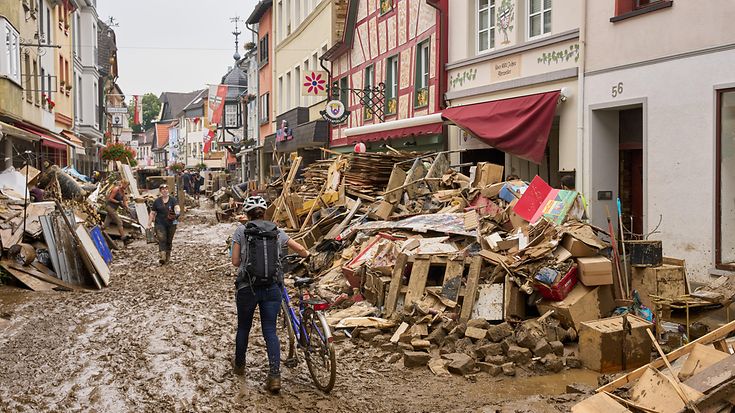Insured flood losses in North Rhine-Westphalia and Rhineland-Palatinate in the range of 4 to 5 billion euros
The most recent estimate of the damage makes it clear: “Bernd” is one of the most devastating storms in the recent past. ”The evaluation by the insurers is still ongoing. An updated damage estimate will follow shortly

Clean-up work in the disaster areas is under way: The damage in Saxony and Bavaria is not yet included in this first estimate. The destroyed infrastructure makes communication and inspection of the damage on site difficult.
Last week's flood disaster in North Rhine-Westphalia and Rhineland-Palatinate, triggered by low-pressure area "Bernd," has caused losses in the billions, according to initial preliminary estimates. "We currently expect insured losses of 4 to 5 billion euros," said Jörg Asmussen, chief executive of the German Insurance Association (GDV), in Berlin on Wednesday. "The damage is likely to be even higher than that of the August flood in 2002 of 4.65 billion euros. Low 'Bernd' is thus one of the most devastating storms in recent history," Asmussen said.
The damage in Saxony and Bavaria is not yet included in this initial estimate. The destroyed infrastructure makes communication and on-site inspection of the damage difficult. Insurers are still evaluating the events. The association announced an updated loss estimate for the July storms for next week.
Most damaging year since 2002
"Overall, this year with storms, flooding, heavy rain and hail is likely to be the most damaging year since 2002," Asmussen said. At that time, insured storm damage was 10.9 billion euros. In June, heavy rain and hail had already caused an estimated insured loss of 1.7 billion euros.
According to Asmussen, insurers have been working under pressure for days to assess and settle claims in the affected areas. "We are doing everything we can to help pragmatically and efficiently so that our customers' claims can be processed quickly and without complications," said the GDV CEO. "My thoughts are with the people who have lost relatives and friends and those who fear for their belongings."
"Compulsory insurance makes sense at best within overall concept"
Asmussen was cautious about the debate on compulsory insurance against natural hazards. "As a single instrument, we reject it because it takes away the incentive to insure against flood and other extreme weather risks," Asmussen said. Mandatory insurance cannot shoulder the costs of failing to adapt to climate impacts, he said. "At best, it would make sense if it were integrated into a new overall concept for land and building planning and disaster protection."
With regard to the emergency flood aid decided by the German government, Asmussen said, "The damage that has now occurred far exceeds the self-help capacities of the municipalities and districts. To alleviate the immediate need, the disbursement of emergency aid therefore makes sense."
Only 46 percent coverage with natural hazard insurance
Nationwide, nearly all residential buildings are covered for windstorm and hail. However, only 46 percent of homeowners have protection against other natural hazards such as heavy rain and floods. "While it is encouraging that nearly half of building owners now have protection against other natural hazards. But for the rest, they should review and adjust their insurance coverage," Asmussen said.
To raise homeowners' awareness of the risk posed by natural hazards, GDV offers the "Natural Hazard Check." Property owners and tenants can use the online platform to find out what damage severe weather has caused in the past at their place of residence and can thus better assess their individual risk.